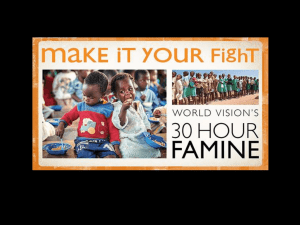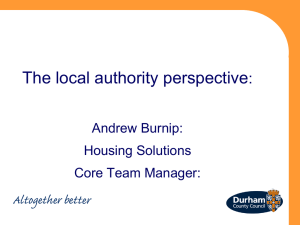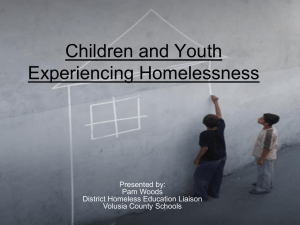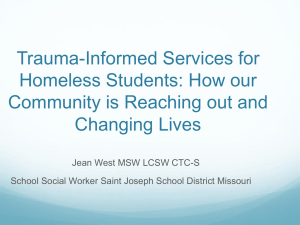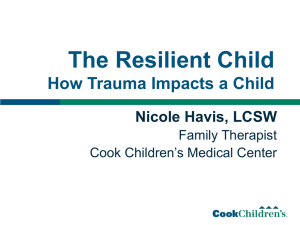Resilience and Empowerment - The National Association for the
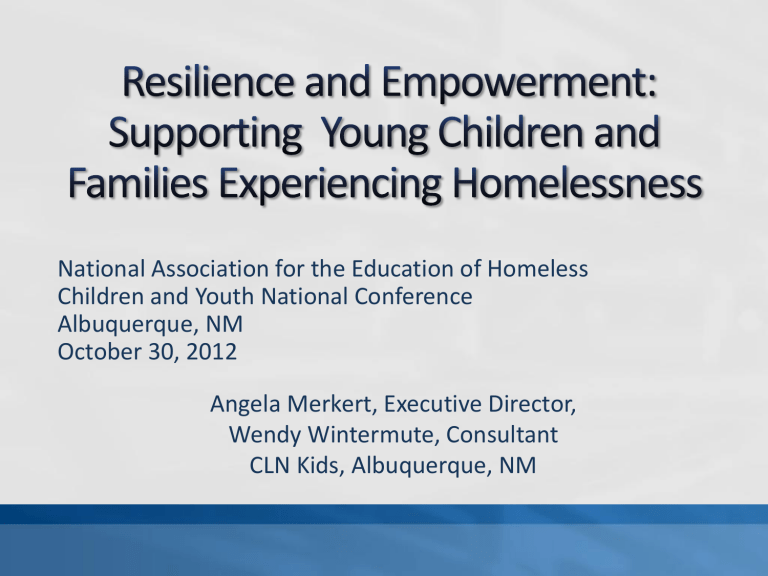
National Association for the Education of Homeless
Children and Youth National Conference
Albuquerque, NM
October 30, 2012
Angela Merkert, Executive Director,
Wendy Wintermute, Consultant
CLN Kids, Albuquerque, NM
The First Five Years:
The importance of early childhood development
Adverse Childhood Events and Environments
Impact of poverty, homelessness and trauma in the early years
Supporting Resilience and Empowerment
A community-wide framework for supporting vulnerable children and families
What is Required
Staff competencies
Organizational capacity
Community network of support
How Children (Really) Succeed
“Hardwires” the stress response
Elevates the level of stress hormones
Results in “embodied memories”
Impairs the development of the prefrontal cortex and executive functions
Learning to fear; danger can be anywhere
Poor nutrition, exposure to toxins
Lack of cognitive stimulation
Lack of support for positive parenting
Lowered expectations and self-fulfilling prophesies
AND STRESS
Stress Executive Functions Skills
Note: Parents are also stressed!
What is Unique?
Trauma
In the context of poverty
Housing instability, highly mobile
83% of homeless children have been exposed to at least one serious violent event.
Four times more likely to have health problems;
Twice as likely to go hungry;
Three times more likely to have emotional and behavioral problems;
Fewer than 25% of homeless children graduate from high school.
30% of foster care children could return home – if they had a home
Half of homeless mothers experience severe depression;
One-third of mothers have made at least one suicide attempt;
Over one-third have a chronic physical health condition.
30% of homeless adults in the U.S. were foster children; these adults are twice as likely to have their own children placed in foster homes.
Respect
Resilience
Empowerment
Concrete supports in times of need
Physical, social and emotional development of children and parents
Nurturing and attachment
Knowledge of parenting and child development – “ages and stages”
Social connections and advocacy
Trauma-informed care
Prevent further trauma
Provide safety, stability, security
Chart a course toward positive development for children and parents
Health
Cognitive/Social/Emotional
Support resilience and asset-building among parents and children
Developmental Issues:
Physical safety and health
Socio-emotional development
Cognitive development
Focus on strengths, build resilience
Developmental Issues:
Nurturing relationships and secure attachments
Individualized assessment and intervention
Concrete support, including appropriate housing
Social/emotional/cognitive development
Focus on strengths, build resilience
Coordinated , Targeted Entry: A common way for families to access homeless services and for providers to quickly link families to the resources they need
Tailored Programs: Getting the right services at the right level and at the right time for each family
Re-Housing: Moving families as rapidly as possible into stable and safe housing
Sustainability: Creating stronger connections to family incomes through education, employment, and other mainstream resources
Community
Awareness &
Support
Service
Systems
Family
Child
Audience Participation
Organizational Capacities
Staff Competencies
Community Readiness
System-Building
Concrete supports in times of need
Physical, social and emotional development of children and parents
Nurturing and attachment
Knowledge of parenting and child development – “ages and stages”
Social connections and advocacy
Community Urgency and Will to Act
Common Vision
“Homelessness is rare , of short duration , and non-recurring.
”
Shared Outcomes and Measurement
Comprehensive, Coordinated Services
Effective Communication
Network Support
CLNKIds www.ClnKids.org
Angela Merkert angela@clnkids.org
Wendy Wintermute wwintermute1@gmail.com





